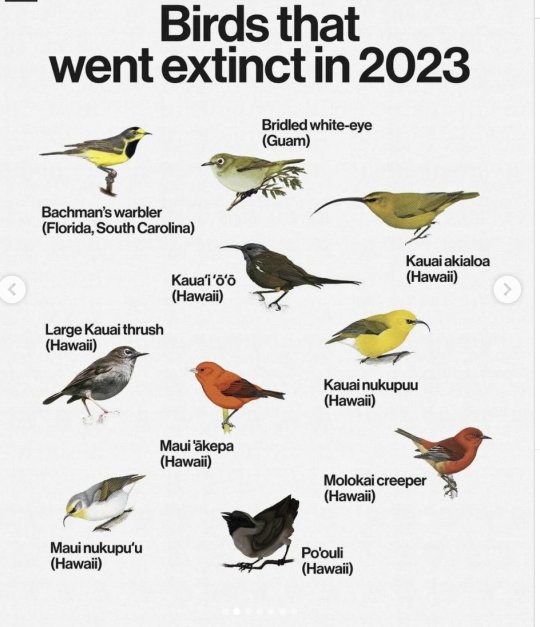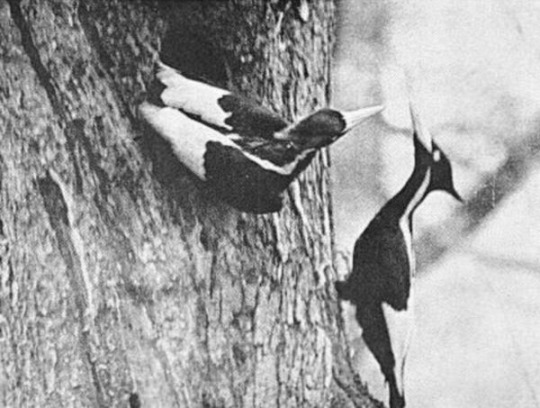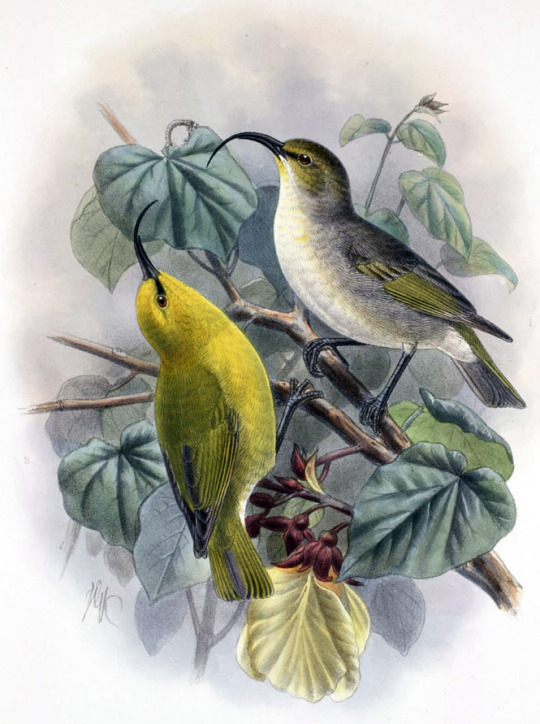#akialoa stejnegeri
Text
So, I saw a post circulating here about the “extinction of birds in 2023“, with this picture attached

My, what a bold claim! All these poor birdies, “went extinct” in just one year alone? Why would such an outrageous, depressing and catchy claim be spread around?
Let’s fact check it.
All the species listed, Bachman’s wabler (Vermivora bachmanii, 1988 or 1980s), Kāmaʻo or large Kauaʻi thrush (Myadestes myadestinus, 1989 or 1987), Bridled white-eye (Zosterops conspicillatus, 1983 and 1983), Kauai ʻakialoa (Akialoa stejnegeri, 1969 or 1960s), Kauaʻi ʻōʻō (Moho braccatus, 1987 and 1987), Kauaʻi nukupuʻu (Hemignathus hanapepe, 1899 and 1899), Maui ʻakepa (Loxops ochraceus, 1988 and 1988), Kākāwahie or Molokaʻi creeper (Paroreomyza flammea, 1963 and 1963), Maui nukupuʻu (Hemignathus affinis, 1896* and 1996 ) and Poʻouli (Melamprosops phaeosoma, 2004 and 2004) are all, indeed, either extinct or possibly extinct, according to IUCN Red List of Threatened Species and U.S. Fish and Wildlife Service.
What are the dates after the scientific names? Well, those all are *last sightings* per IUCN Red List and USFWS accordingly. So, these birds were not seen for DECADES and in one case FOR MORE THAN A GODDAMN CENTURY. And sure as hell there is NO information about them very suddenly being gone all last year.
What’s the deal then? Where did this claim even come from? Well, likely from this article "21 Species Delisted from the Endangered Species Act due to Extinction" from U.S. Fish & Wildlife Service. It includes all the birds in the picture (with the last date of sight, listed above).
From the article: “The U.S. Fish and Wildlife Service is delisting 21 species from the Endangered Species Act due to extinction. Based on rigorous reviews of the best available science for each of these species, the Service determined these species are extinct and should be removed from the list of species protected under the ESA. Most of these species were listed under the ESA in the 1970s and 80s and were in very low numbers or likely already extinct at the time of listing.”
They didn’t ALL fucking suddenly drop dead all in the same year – if they did, as some other people have already pointed out, there would be an uproar EVERYWHERE. Ornithologists alone would not let it live down. They were officially delisted from endangered status by U.S. Fish & Wildlife Service that year, there was a proposition to do so back in 2021, too. Some were already declared extinct before by IUCN.
Despite not being seen for so long, they remained on the list of critically endangered for a long while, cause you cannot just immediately declare a species extinct. There’s no RTS unit amount number that goes to 0 once there’s nothing left; people keep checking for them over and over and over again. Sometimes it turns out that a species previously thought to be extinct is actually still out there. Attenborough's long-beaked echidna for example was last sighted SIXTY YEARS ago before being sighted again in 2023. It was thought to be extinct for a while, before 2007, when signs of its activity was spotted again. More often than not though, a species turns out to be actually very extinct, unfortunately – like in this case.
I cannot possibly know if the creators of this picture, or people that spread it on social media ever had good intentions behind it for awareness, however even if they did, it turned out to be nothing but very blatant misinformation, with a fearmongering effect. The only thing this achieves is not awareness of habitat destruction or pernicious tourist influence or climate change or what have you – the only thing this achieves is despair and panic. People already so casually fall into complete doomerism, they’re very used to hear bad news. And guess what doomerists do? Typically nothing. It renders people helpless. It’s not gonna make people get up and be ready for action, it, at best, would just make people feel sad and/or angry, or at worst, feed into the current alarming rise of ecofascism. NOTHING good comes out of this. At the very goddamn least, no one needs to lie to promote a goal.
The aim of the USFWS article, on the other hand, IS to make people aware about those animals that are already gone from the face of the planet, no matter how long ago, and that now we have to protect those animals that are critically endangered and still out there – to not have to repeat those tragedies.
Be very critical of what you see on the internet, especially if it’s sited with no sources. Especially-especially if it causes a strong emotional reaction. Lies and misinfo could only hurt the cause, no matter how noble. And please, be aware of your local wildlife status. Check in with it accoding to trusted sources.
[*sic, possibly a typo and it was meant to be 1996, other confirmed date listed there is 1989]
Addendum: I could not for sure find the uncredided (who woulda thunken that ppl that don't cite their sources would also not credit the artists) author(s) of the bird illustrations. If someone finds them, please, let me know!
Edit: Huge thanks to moosefinch for finding the sources for the artwork! I'll add their contribution below:
"Image sources!
The Kauai ʻakialoa, Kauaʻi ʻōʻō, Maui ʻakepa and Kauaʻi nukupuʻu are from Birds of the World.
The "Maui nukupuʻu" and "Molokaʻi creeper" illustrations are also Birds of the World, but are actually a female Kauaʻi nukupuʻu (the other being the male) and Laysan honeycreeper/Laysan ʻapapane respectively.
The bridled white-eye is by Lauren Helton according to this source.
Bachman's warbler is by Lynn Hawkinson Smith/smithhouse2 according to this Etsy listing.
The Poʻouli is by Christina Czajkowski."
#ah I just now see that the tumblr reblog of the pic and the twitter thread attached was deleted#yet the post is still in circulation. The damage lingers#so fucking irresponsible#fact check#misinformation#birds#bird#ecology#environmentalism#extinction#conservation#species conservation#animals#hawaiʻi#important
810 notes
·
View notes
Text






On September 30, 2021, the U.S. Fish and Wildlife service has proposed to de-list 23 species and declare them extinct. Official government source here. Species information is from Wikipedia.
This is PART 1 with birds only. I will upload more species later.
Vermivora bachmanii (Bachman's warbler) was threatened by habitat loss, hunting, and a hurricane in 1932, and its last confirmed sighting was in 1988. (image)
Zosterops conspicillatus (bridled white-eye) is extinct in Guam but some subspecies may exist elsewhere, but I cannot find much information about it. (image)
Campephilus principalis (ivory-billed woodpecker) declined due to habitat destruction and has not had a confirmed sighting since 1944. (image)
Akialoa stejnegeri (Kauai ʻakialoa) was a Hawaiian honeycreeper that declined due to habitat loss and due to diseases spread by mosquitos introduced in 1826; the last confirmed sighting was in 1967. (image)
Hemignathus hanapepe (Kauaʻi nukupuʻu) was a Hawaiian honeycreeper that lost its habitat from slash-and-burn farming and was likely extinct by the early 1900s. (image)
Moho braccatus (Kauaʻi ʻōʻō) was a Hawaiian songbird that declined due to habitat destruction and invasive species such as the rat, pig, and mosquito. They were last seen in 1985 and the last song recording of a lone male was taken in 1987. (image)
#g postin#conservation#recently extinct#news#bachman's warbler#bridled white-eye#ivory-billed woodpecker#kauai 'akialoa#Kauaʻi nukupuʻu#Kauaʻi ʻōʻō#long post#let me know if i got anything wrong! i was zooming#bird
40 notes
·
View notes
Text








On September 30, 2021, the U.S. Fish and Wildlife service has proposed to de-list 23 species and declare them extinct. Official government source here. Remember that its evaluations may differ from IUCN.
This is PART 2 focusing on Hawaiian birds. Many Hawaiian bird species have gone extinct due to habitat destruction, bad weather from climate change, and introduced species and diseases. The history and extinction of these species will be expanded upon below!
If you can, please support conservation efforts to save the species that remain!
Akialoa stejnegeri (Kauai ʻakialoa) was a honeycreeper that declined due to habitat loss and due to diseases spread by mosquitos introduced in 1826; the last confirmed sighting was in 1967. (image)
Hemignathus hanapepe (Kauaʻinukupuʻu) was a honeycreeper that lost its habitat from slash-and-burn farming and was likely extinct by the early 1900s. ICUN lists it as critKauaʻi nukupuʻuically endangered, possibly extinct. (image)
Hemignathus affinis (Maui nukupuʻu) declined in the 1900s and the last confirmed sighting was in 1994; there have been alleged sightings since then, but they are usually other similar species. ICUN lists it as critically endangered, possibly extinct. (image)
Loxops ochraceus (Maui ʻakepa) was once common in Maui but declined from the impact of introduced plants and animals, and the avian flue from introduced mosquitoes. The last known sighting was of a lone individual in 1988. ICUN lists it as critically endangered, possibly extinct. (image)
Paroreomyza flammea (kākāwahie) was a honeycreeper that was trapped by Native Hawaiians for its bright feathers, but mostly declined from the same reasons as the other birds above. (image)
Moho braccatus (Kauaʻi ʻōʻō) declined due to habitat destruction and invasive species such as the rat, pig, and mosquito. They were last seen in 1985 and the last song recording of a lone male was taken in 1987. (image)
Myadestes myadestinus (kāmaʻo) was a thrush that was once common on Kaua'i, but was mostly wiped out by the early 1800s from habitat destruction and avian malaria carried by introduced mosquitoes; the last probable sighting was in 1989. (image)
Melamprosops phaeosoma (poʻo-uli) declined rapidly since 1945 from introduced species and avian malaria, and despite attempts to protect and breed them, the last few individuals died around 2004. (image)
#Kauai ʻakialoa#Maui nukupuʻu#Kauaʻi nukupuʻu#Maui ʻakepa#kākāwahie#Kauaʻi ʻōʻō#kāmaʻo#poʻo-uli#conservation#recently extinct#bird#Hawai'i#Hawaii#LONG POST#g postin
11 notes
·
View notes